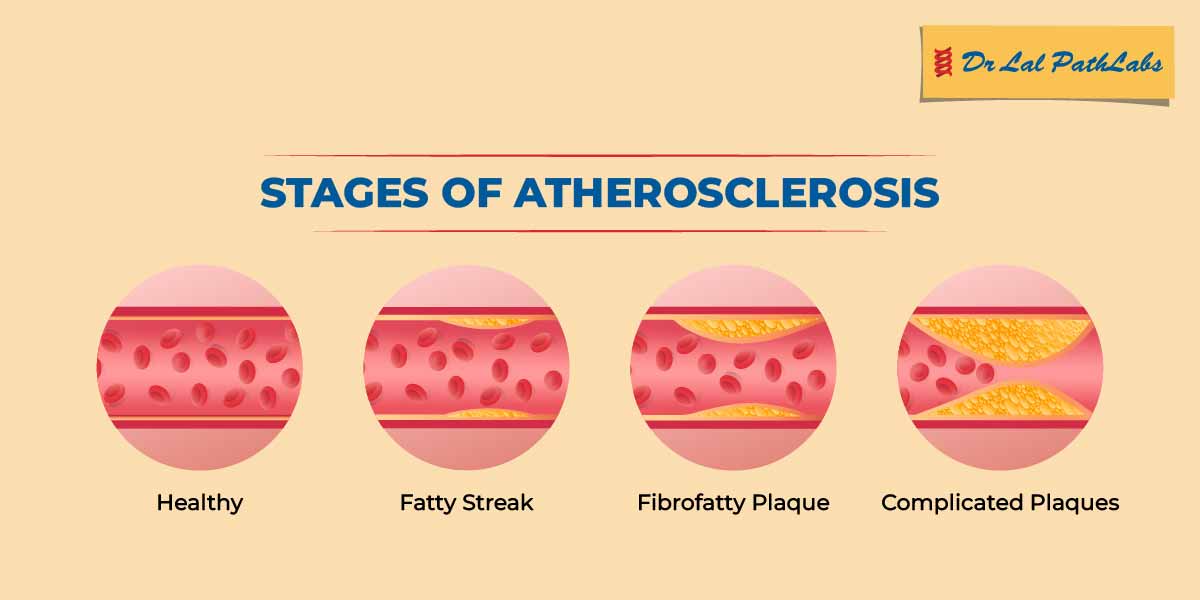Atherosclerosis: Symptoms & Diagnosis
Introduction
Atherosclerosis is a common yet potentially serious medical condition that affects millions of people worldwide. It is a progressive disease that involves the buildup of plaque inside the arteries, leading to the narrowing and hardening of these vital blood vessels. In this blog, we will delve into the fundamentals of atherosclerosis, explore its causes, and identify the various risk factors associated with this condition.

What is Atherosclerosis?
Atherosclerosis refers to the gradual accumulation of plaque, consisting of cholesterol, fatty substances, cellular waste products, calcium, and fibrin, within the inner lining of arteries. Over time, this plaque build-up can hinder the smooth flow of blood, leading to diminished oxygen and nutrient supply to organs and tissues throughout the body.
What Causes Atherosclerosis?
The exact cause of atherosclerosis remains multifactorial, with several interconnected factors contributing to its development. The primary cause is believed to be chronic inflammation of the arterial walls. This inflammation triggers a series of events that lead to plaque formation and progression. Key contributors to atherosclerosis include:
- Cholesterol Imbalance: Elevated levels of low-density lipoprotein (LDL) cholesterol, often referred to as “bad” cholesterol, can promote the accumulation of plaque in arterial walls. Conversely, high-density lipoprotein (HDL) cholesterol, known as “good” cholesterol, helps remove excess cholesterol from arteries, offering protection against atherosclerosis.
- High Blood Pressure: Hypertension exerts excessive force on arterial walls, causing damage and making them more susceptible to plaque formation.
- Smoking: Cigarette smoke contains numerous harmful chemicals that promote inflammation and damage the inner lining of blood vessels, facilitating the deposition of plaque.
- Diabetes: Individuals with diabetes often have increased levels of blood sugar, which can damage the inner lining of arteries and accelerate plaque formation.
- Genetics and Family History: Certain genetic factors and a family history of atherosclerosis can contribute to an individual’s susceptibility to developing the condition.
Risk Factors of Atherosclerosis
Atherosclerosis can affect anyone, but several risk factors increase the likelihood of its occurrence. These include:
- Age and Gender: The risk of atherosclerosis increases with age, and men generally face a higher risk until women reach menopause. After menopause, the risk for women catches up due to hormonal changes.
- Unhealthy Diet: Consuming a diet rich in saturated and trans fats, cholesterol, and processed foods can raise LDL cholesterol levels, leading to atherosclerosis.
- Sedentary Lifestyle: Lack of regular physical activity can contribute to obesity, high blood pressure, and abnormal lipid profiles, all of which promote atherosclerosis.
- Obesity: Being overweight or obese can contribute to elevated cholesterol levels, hypertension, and diabetes, all of which increase the risk of atherosclerosis.
- High Blood Pressure: Hypertension damages arterial walls, making them more susceptible to plaque accumulation.
- Diabetes: Individuals with diabetes have an increased risk of atherosclerosis due to elevated blood sugar levels and metabolic abnormalities.
- Smoking and Tobacco Use: Smoking damages the arteries and accelerates plaque formation, significantly increasing the risk of atherosclerosis.
- Family History: Having a close family member with a history of atherosclerosis increases the likelihood of developing the condition.
What are the Symptoms of Atherosclerosis?
The symptoms of atherosclerosis can vary depending on the specific arteries affected and the organs or tissues they supply.
Here are some common symptoms associated with atherosclerosis:
- Chest pain or discomfort that occurs when the heart muscle does not receive an adequate supply of oxygen-rich blood.
- Shortness of breath
- Leg pain or cramping, particularly during physical activity (claudication).
- Erectile dysfunction
- Stroke symptoms
- Abdominal pain
How is Atherosclerosis Diagnosed?
Here are some common methods used to diagnose atherosclerosis:
Your doctor will inquire about your symptoms, medical history, and risk factors for atherosclerosis, such as smoking, diabetes, high blood pressure, and high cholesterol.
Blood Tests
- Lipid Profile: A blood test to measure cholesterol levels, including total cholesterol, low-density lipoprotein (LDL) cholesterol, high-density lipoprotein (HDL) cholesterol, and triglycerides.
- High-Sensitivity C-Reactive Protein (hs-CRP): This test measures the level of inflammation in your body, as chronic inflammation is associated with atherosclerosis.
Angiography
This invasive procedure involves injecting a contrast dye into the arteries and taking X-ray images (angiograms) to visualize the blood flow and identify blockages.
Stress Tests
- Exercise Stress Test: This test evaluates how your heart responds to physical exertion, usually on a treadmill or stationary bike, while monitoring your heart rate, blood pressure, and electrocardiogram (ECG) changes.
- Nuclear Stress Test: A radioactive tracer is injected into your bloodstream, and special cameras capture images of blood flowing to your heart at rest and during exercise.
Cardiac Catheterization and Coronary Angiography
- This invasive procedure involves inserting a thin tube (catheter) into a blood vessel, usually in the groin or wrist, and guiding it to the heart. Contrast dye is then injected to visualize the coronary arteries and identify any blockages or narrowing.
The choice of diagnostic tests depends on the specific symptoms, risk factors, and clinical judgment of your healthcare provider. It is essential to discuss any concerns or symptoms with a medical professional to determine the most appropriate diagnostic approach for assessing atherosclerosis.
Conclusion
Atherosclerosis is a complex disease driven by a combination of factors, including cholesterol imbalances, chronic inflammation, and lifestyle choices. Understanding the causes and risk factors associated with atherosclerosis empowers individuals to make informed decisions regarding their health. By adopting a heart-healthy lifestyle, managing risk factors, and seeking medical guidance, it is possible to reduce the risk of atherosclerosis and its associated complications, promoting long-term cardiovascular health.













